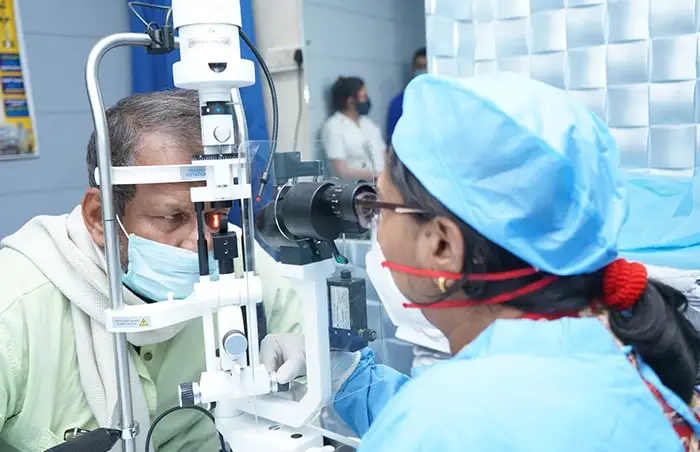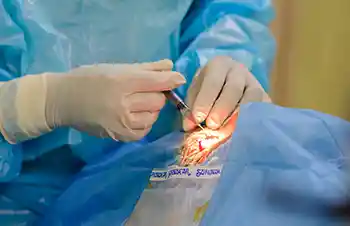Our eye is like a camera. The front of our eye comprises a special lens that receives light and turns it into visual images that are then sent to the brain. This area is termed as retina and it is covered with nerve cells that react to light. Underneath this retina, there is a network of blood vessels. These blood vessels usually develop quickly in the last few weeks before the birth of a baby. Retinopathy of prematurity, or ROP, occurs when these blood vessels in a baby's eye develop abnormally. In some premature babies who are born before 36 weeks of gestation or weigh less than 2 Kg during birth, the blood vessels grow abnormally, into parts of the eye where they normally do not belong. This can result in scaring the tissue inside the eye. The scar tissue can eventually damage the retina and cause vision loss. Most ROP gets resolved without causing much damage to the retina. Although when ROP is severe, it can result in the retina pulling away or detaching from the wall of the eye and this can eventually cause blindness. It is only through proper screening and treatment that ROP can be prevented or adequately treated. This world is beautiful and those little eyes deserve to look at the world with the most perfect vision.
Who are at the most risk of ROP?
- All babies born before 36 weeks of gestation
- Infants who weigh less than 2 kg at birth
It is very important, that these babies are properly screened and examined by an ophthalmologist within 30 days of birth.
The primary causes of ROP
In normal conditions, the blood vessels of the retina start to develop in the fourth month of pregnancy and finish complete development around 9 months of pregnancy. An early birth can disrupt the normal growth of the vessels. The retina then starts to develop new blood vessels that are abnormal. This is termed retinal neovascularization.
These abnormal blood vessels can grow in the wrong direction. The blood vessels are attached to the retina, so if they grow too far in the wrong direction, they can pull the retina up off the back of the eye. This is a type of retinal detachment. The vessels may stop growing or grow abnormally from the retina into the back of the eye. Because the vessels are delicate, they can leak and cause bleeding in the eye.

Through the years, it has been identified by professionals that there are several factors that seem to worsen retinopathy of prematurity. One such case is if a premature baby is supplied with too much oxygen. Avoiding such things has effectively reduced the number of infants suffering from severe retinopathy of prematurity.
Get to know about the risk factors
Other than premature birth, there are several risk factors that cause constant conflict between normal retinal vascularization and the requirement of adequate oxygen by the developing retina.
- Low birth weight
- Young gestational age
- High level of carbon dioxide in the blood
- Low blood acidity
- Low blood oxygen
- Respiratory distress
- Slow heart rate
- Heart disease
- Poor postnatal growth
- Intraventricular hemorrhage
- Blood transfusion
Look out for the Symptoms
The changes in blood vessels cannot be observed with the naked eye. At the early stages of ROP, the subtle changes in an infant’s retina are not usually possible to be detected by parents as there are no clear symptoms at early stages. Only a pediatric ophthalmologist can detect signs of retinopathy of prematurity with the help of special instruments to examine the baby's retina.
Symptoms of severe ROP include-
- Nystagmus- Abnormal eye movements, that are wandering and shaking of eyes
- Strabismus- Crossed eyes
- Myopia- Severe nearsightedness
- Leukocoria- White-looking pupils
- Trouble in recognizing faces
Primary ways to prevent ROP
It is commonly said that prevention is better than cure, and treatment of ROP is not an exception. In order to prevent ROP to damage your child’s precious vision, proper retinal examinations by an ophthalmologist from an early stage are very important.
- Every premature baby, who is born before 36 weeks of gestation or weighs less than 2 kg at birth, should be screened and examined within 30 days of birth.
- Screenings of infants who are at risk and appropriate follow-up exams should be scheduled according to the results of the first exam to identify if the child is in need of treatment. Usually, the baby does not need another exam if the development of blood vessels in both retinas is completely normal. Parents should learn from the doctor what follow-up eye exams are required and the date and timing of such sessions.
- Although, the best way to prevent ROP is to take the necessary steps to avoid premature birth in the first place. Impeding other problems of prematurity can also help prevent ROP- related difficulties.
The stages of severity
The severity of ROP can be marked into 5 stages. Ophthalmologists use these stages to infer and keep track of the severity of ROP
- Stage 1: Demarcation Line- In this stage, the thin and flat line in the retina plane separates the avascular retina anteriorly from the vascularized retina posteriorly.
Symptoms- Mild growth of abnormal blood vessels - Stage 2: Ridge- A ridge develops from the demarcation line and extends above the plane of the retina. Infants in the 1st and 2nd stages of ROP usually get resolved without treatment and don’t face any loss of vision. Although, eye specialists will examine the babies carefully to observe if their ROP gets worse.
Symptoms- Moderate growth of abnormal blood vessels - Stage 3: Extraretinal Fibrovascular Proliferation- In this stage, the extraretinal proliferating tissue gets continuous with the posterior aspect of the ridge, causing a tattered appearance. Even though some babies in stage 3 get better with the least amount of treatment and carry on their lives with healthy vision, others need thorough and advanced treatment to prevent abnormal blood vessels from having harmful effects on the retina and causing retinal detachment which can cause vision loss.
Symptoms- Severe growth of abnormal blood vessels - Stage 4: Partial Retinal Detachment- Babies in stage 4 usually suffer from partially detached retinas and need medical treatment. In this stage, retinal detachments are normally concave. Retinal detachments start at the point of fibrovascular attachment to the vascularized retina and the extent of detachment depends on the amount of the present neovascularization.
Symptoms- Abnormal growth of blood vessels with a partially detached retina - Stage 5: Total Retinal Detachment- In stage 5, the retina detaches entirely. Even with advanced treatment and surgery, babies in stage 5 may have vision loss or even complete blindness.
Symptoms- Complete detachment of the retina
Even though doctors usually start treatment from stage 3, It’s also possible that in any stage the ROP might get worse quickly and need treatment. This is the reason why it’s so important to make sure that your baby is getting their follow-up exams according to the preplanned schedule. Finding out and treating ROP at the earliest stages is the best way to lower the chances to cause serious problems.
Get ROP diagnosed
All premature babies who may be at risk for ROP are cautiously monitored for the condition beginning a few weeks after birth. It is suggested that the examination should be done within 30 days of birth.
The doctor who is trained and a specialist in the treatment and diagnosis of ROP will examine your child’s eyes. The baby’s eyes are dilated with eye drops with the use of a special instrument, the doctor looks inside the eye. In this examination, it is inferred how much of the retina may be affected and damaged by retinopathy of prematurity. The doctor grades the conclusions of the examination on a scale of five stages.
In case any signs of ROP are detected, The ophthalmologist will recommend that the baby needs a follow-up evaluation. If the baby needs follow-up check-ups the doctor will observe the eyes again every 1 to 3 weeks until they are sure that there is no need to worry about the risk of retinal detachment.
It is the responsibility of the parents to get their baby’s follow-up exams on a pre-planned schedule. This is the most effective way to get ROP diagnosed in an early stage and begin the necessary treatment.
The effective treatment of ROP
Treatment for ROP depends on the stage and severity of the condition. The milder stages of the disease typically resolve by themselves and don't require treatment. However, if the disease has progressed to a point where your baby's vision is at risk, treatment is needed.
- Laser photocoagulation– This advanced process is used to prevent the abnormal growth of blood vessels in the retina. This is a laser ablation method that is applied to the immature area to scar the peripheral retina. A laser beam is focused onto a spot on the retina where the abnormal blood vessels are growing. The beam slowly heats up the particular spot, resulting in a burn in the blood vessels and impeding the growth. The abnormal blood vessels then eventually disappear.
- Cryoretinopexy- This method is also an effective way to stop the growth of abnormal blood vessels. In this process, a cryoprobe is placed on the outside of the eye. The tip of this particular instrument gets very cold and it freezes the abnormal blood vessels.
- Scleral buckling- This method is often used in the severe stages of ROP, especially when there is a retinal detachment which can cause loss of vision. A flexible rubber band made of silicon is placed around the sclera and it pushes the inside surface of the eye against the retina and in turn pushes the detached retina closer to the outer eyewall. The elastic band is finally removed when the retina successfully becomes reattached to the inside surface of the eye.
- Vitrectomy- In some cases, the surgeon might have to eliminate some of the gel-like fluid that fills the inside of the eye. This fluid is called the vitreous fluid, and the procedure that removes it is called a vitrectomy. The surgeon makes tiny openings in the wall of the eye to remove the vitreous and then replaces it with a saline solution. The surgeon will also remove the scar tissue and eases the pull on the retina. Laser treatment may also be done after this to completely treat the retina and seal it in its position. This method helps to reduce the probability of a retinal detachment and thus prevents vision loss.
- Injections- Eye specialists also inject medicines like anti-VEGF drugs into the eye of the baby. These medicines block the abnormal growth of blood vessels. This is usually done as an alternative to laser surgery.
Curing ROP is caring for your child’s future
Around 50,000 infants are affected annually by ROP. The majority of these babies with severe degrees of vision loss which is related to ROP have other factors and problems related to premature birth. These infants need detailed care and several different treatments.
According to the studies, about 1 out of 10 infants who have early changes due to ROP develops a more severe retinal disease. ROP in its critical stages may lead to major loss or even blindness. The key factor to preventing such conditions is early detection and treatment.
The most important and responsible thing the parents can do to get the best result for their baby is to keep up with the appointments according to the schedule and follow the doctor's suggestions and advice even after the treatment.
It is very important to take the premature baby for an eye examination within 30 days of birth and also to keep up with the following medical sessions. The timing of these exams and follow-up exams are critical as delays in treatment will increase the risk of severe vision loss. Every premature infant needs the long-term detailed attention of an ophthalmologist to ensure complete safety against ROP-related damages.
The best ROP specialists at Renuka Eye Institute observe and treat your little one with care. The doctor will also discuss every detail of your child’s treatment with you. Our goal at Renuka Eye Institute is to treat and reduce the risk of retinal detachment of your child and protect the valuable vision that is new and has so much left to see in this world.









